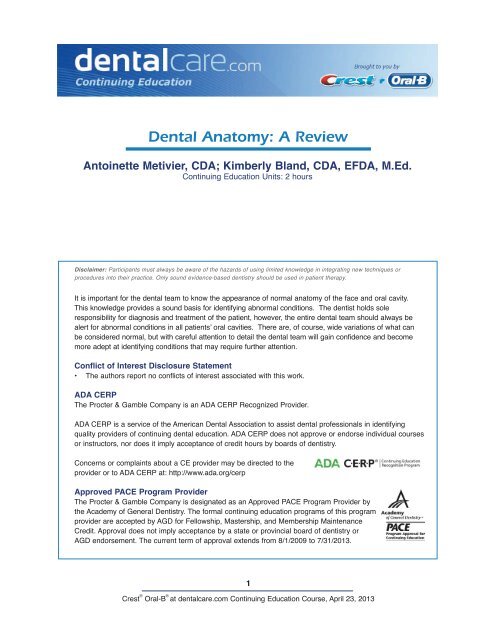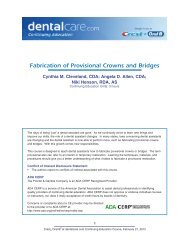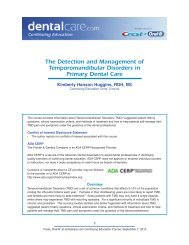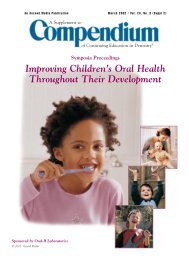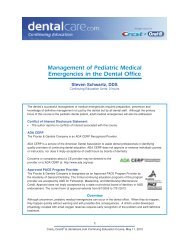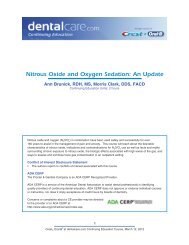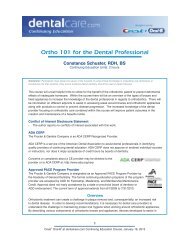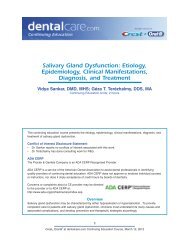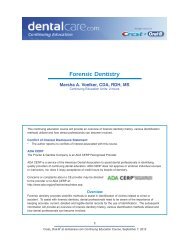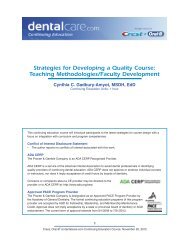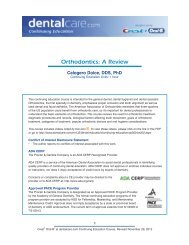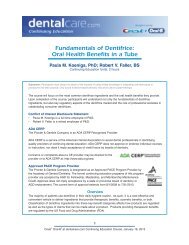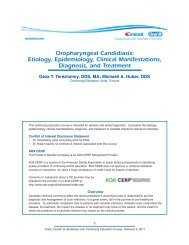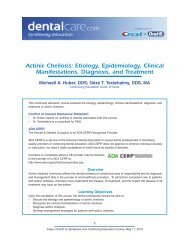CE 421 - Dental Anatomy: A Review - DentalCare.com
CE 421 - Dental Anatomy: A Review - DentalCare.com
CE 421 - Dental Anatomy: A Review - DentalCare.com
You also want an ePaper? Increase the reach of your titles
YUMPU automatically turns print PDFs into web optimized ePapers that Google loves.
<strong>Dental</strong> <strong>Anatomy</strong>: A <strong>Review</strong><br />
Antoinette Metivier, CDA; Kimberly Bland, CDA, EFDA, M.Ed.<br />
Continuing Education Units: 2 hours<br />
Disclaimer: Participants must always be aware of the hazards of using limited knowledge in integrating new techniques or<br />
procedures into their practice. Only sound evidence-based dentistry should be used in patient therapy.<br />
It is important for the dental team to know the appearance of normal anatomy of the face and oral cavity.<br />
This knowledge provides a sound basis for identifying abnormal conditions. The dentist holds sole<br />
responsibility for diagnosis and treatment of the patient, however, the entire dental team should always be<br />
alert for abnormal conditions in all patients’ oral cavities. There are, of course, wide variations of what can<br />
be considered normal, but with careful attention to detail the dental team will gain confidence and be<strong>com</strong>e<br />
more adept at identifying conditions that may require further attention.<br />
Conflict of Interest Disclosure Statement<br />
• The authors report no conflicts of interest associated with this work.<br />
ADA <strong>CE</strong>RP<br />
The Procter & Gamble Company is an ADA <strong>CE</strong>RP Recognized Provider.<br />
ADA <strong>CE</strong>RP is a service of the American <strong>Dental</strong> Association to assist dental professionals in identifying<br />
quality providers of continuing dental education. ADA <strong>CE</strong>RP does not approve or endorse individual courses<br />
or instructors, nor does it imply acceptance of credit hours by boards of dentistry.<br />
Concerns or <strong>com</strong>plaints about a <strong>CE</strong> provider may be directed to the<br />
provider or to ADA <strong>CE</strong>RP at: http://www.ada.org/cerp<br />
Approved PA<strong>CE</strong> Program Provider<br />
The Procter & Gamble Company is designated as an Approved PA<strong>CE</strong> Program Provider by<br />
the Academy of General Dentistry. The formal continuing education programs of this program<br />
provider are accepted by AGD for Fellowship, Mastership, and Membership Maintenance<br />
Credit. Approval does not imply acceptance by a state or provincial board of dentistry or<br />
AGD endorsement. The current term of approval extends from 8/1/2009 to 7/31/2013.<br />
1<br />
Crest ® Oral-B ®<br />
at dentalcare.<strong>com</strong> Continuing Education Course, April 23, 2013
Overview<br />
It is important for the dental team to know the appearance of normal anatomy of the face and oral cavity.<br />
This knowledge provides a sound basis for identifying abnormal conditions. The dentist holds sole<br />
responsibility for diagnosis and treatment of the patient, however, the entire dental team should always be<br />
alert for abnormal conditions in all patients’ oral cavities. There are, of course, wide variations of what can<br />
be considered normal, but with careful attention to detail the dental team will gain confidence and be<strong>com</strong>e<br />
more adept at identifying conditions that may require further attention.<br />
Learning Objectives<br />
Upon <strong>com</strong>pletion of this course, the dental professional should be able to:<br />
• Identify and describe the appearance of the normal anatomic structures of the face and oral cavity.<br />
• Identify and describe the following: types of teeth and their functions, the divisions of a tooth, the tissues<br />
of a tooth, the surfaces of a tooth, and the anatomical landmarks of teeth.<br />
• Discuss the importance of occlusion and describe the classifications of occlusion.<br />
• Describe the two dentitions and the types of teeth in each dentition.<br />
• Discuss the importance of the primary teeth.<br />
• Identify and describe the <strong>com</strong>ponents of the periodontium, and discuss the importance of the<br />
periodontium.<br />
Course Contents<br />
• Glossary<br />
• Normal Anatomic Structures of the Face and<br />
Oral Cavity<br />
Facial Landmarks<br />
Landmarks of the Oral Cavity<br />
Landmarks of the Palate<br />
Landmarks of the Tongue<br />
Landmarks of the Floor of the Mouth<br />
• Types of Teeth and Their Functions<br />
• Divisions of a Tooth<br />
• Tissues of a Tooth<br />
• Surfaces of Teeth<br />
• Anatomical Landmarks of the Teeth<br />
• Arrangement of the Teeth in the Oral Cavity<br />
Arches and Quadrants<br />
Occlusion<br />
• Classifications of Occlusion<br />
• Dentitions<br />
Primary Dentition<br />
Permanent Dentition<br />
D-A-Q-T System<br />
• Periodontium<br />
Gingival Unit<br />
Attachment Unit<br />
• Conclusion<br />
• Course Test<br />
• References<br />
• About the Authors<br />
2<br />
Glossary<br />
adjacent – Next to, or nearby.<br />
anterior – Toward the front.<br />
apex – The end of the root of a tooth.<br />
apical foramen – The opening at the end of the<br />
root of a tooth.<br />
bifurcated – One tooth with two roots.<br />
bifurcation – The area in a two-rooted tooth where<br />
the roots divide.<br />
buccal – The surface of a posterior tooth facing the<br />
cheeks.<br />
cementoenamel junction (<strong>CE</strong>J)/cervical line –<br />
The area of a tooth where the cementum of the root<br />
and the enamel of the crown meet.<br />
cementum – The tissue covering the root of a tooth.<br />
cingulum – A smooth, rounded bump on the<br />
cervical third of the lingual surface of anterior teeth.<br />
contact area – The area on the proximal surface of<br />
a tooth where it touches an adjacent tooth.<br />
Crest ® Oral-B ®<br />
at dentalcare.<strong>com</strong> Continuing Education Course, April 23, 2013
deciduous teeth – The first set of teeth; the<br />
primary teeth.<br />
dentin – The tissue of a tooth that <strong>com</strong>prises the<br />
main inner portion of the tooth; it is covered by<br />
cementum on the root and enamel on the crown.<br />
dentition – Set of teeth; the natural teeth in position<br />
in the dental arches.<br />
distal – The surface of a tooth that is away from<br />
the midline.<br />
facial – The surface of a tooth that faces the lips or<br />
cheeks; includes the labial and buccal surfaces.<br />
fissure – A groove or natural depression on the<br />
surface of a tooth.<br />
fossa – A shallow, rounded or angular depression<br />
on the surface of a tooth.<br />
gingiva – The mucous membrane tissue that<br />
surrounds the teeth.<br />
incisal – Cutting edge of anterior teeth.<br />
incisive foramen – A passageway through the<br />
bone of the hard palate for vessels and nerves;<br />
found just lingual to the central incisor region.<br />
interproximal – Between the proximal surfaces of<br />
adjacent teeth.<br />
labial – The surface of anterior teeth facing the lips.<br />
lingual – The surface of a tooth that faces the tongue.<br />
mandibular – Pertaining to the lower jaw.<br />
maxillary – Pertaining to the upper arch.<br />
mesial – The surface of a tooth that faces the<br />
midline.<br />
midline – An imaginary vertical plane that divides<br />
the body into equal right and left halves.<br />
mucogingival junction – The line or area where<br />
the alveolar mucosa meets the attached gingiva.<br />
mucosa – The tissue lining the oral cavity.<br />
3<br />
occlusal – The biting surface of a posterior tooth.<br />
periapical – The area surrounding the apex of a<br />
tooth.<br />
periodontium – The tissues that surround and<br />
support the teeth; includes the gingiva, the alveolar<br />
mucosa, the cementum, the periodontal ligament,<br />
and the alveolar bone.<br />
posterior – Toward the back.<br />
quadrant – One-fourth of the mouth; half of the<br />
maxillary or mandibular arch.<br />
succedaneous – Permanent teeth that replace<br />
primary teeth.<br />
sulcus, gingival – The space between the tooth<br />
and the free gingiva.<br />
Normal Anatomic Structures of the Face<br />
and Oral Cavity<br />
Facial Landmarks<br />
The following are landmarks that are found on the<br />
face (Figures 1-3). 1<br />
• Ala: Outer edge (wing) of the nostril.<br />
• Philtrum: Shallow depression between the<br />
bottom of the nose and the top of the upper lip.<br />
• Vermilion Zone: Extraoral reddish portion of<br />
the lips.<br />
• Vermilion Border: The border of the lips where<br />
the skin of the face meets the Vermilion zone.<br />
• Nasolabial Sulcus: Linear depression of the<br />
face that runs from the ala to the corner of the<br />
mouth.<br />
• Labial Commissures: Corners of the mouth<br />
where upper lip meets the lower lip.<br />
• Tubercle of the Lip: Small projection of tissue<br />
in the middle of the upper lip.<br />
• Nasion: Midpoint between the eyes just below<br />
the eyebrows.<br />
• Outer Canthus of the Eye: Fold of tissue at<br />
the outer corner of the eyelids.<br />
• Inner Canthus of the Eye: Fold of tissue at<br />
the inner corner of the eyelids.<br />
• Tragus of the Ear: The triangular cartilage<br />
projection anterior to the external opening of<br />
the ear.<br />
Crest ® Oral-B ®<br />
at dentalcare.<strong>com</strong> Continuing Education Course, April 23, 2013
Figure 1. Regions of the Face. There are nine regions of the face as shown in the<br />
photograph.<br />
Image courtesy of Modern <strong>Dental</strong> Assisting, 10th Ed.<br />
Figure 2. Features of the Face. This photograph<br />
highlights different facial features.<br />
Image courtesy of Modern <strong>Dental</strong> Assisting, 10th Ed.<br />
Landmarks of the Oral Cavity<br />
There are various methods of <strong>com</strong>pensation The<br />
following are landmarks found in the oral cavity<br />
(Figures 4-7). 1,2<br />
• Masticatory Mucosa: Heavily keratinized<br />
tissue that lines the hard palate and tongue.<br />
• Alveolar Mucosa: Lightly keratinized tissue<br />
4<br />
Figure 3. Frontal View of the Lips. This photograph<br />
points out the parts of the lips.<br />
Image courtesy of Modern <strong>Dental</strong> Assisting, 10th Ed.<br />
that lines floor of the mouth and covers the<br />
alveolar processes.<br />
• Labial and Buccal Mucosa: Thinly keratinized<br />
tissue that lines the inner surface of the lips and<br />
cheeks (Figures 5 & 6).<br />
• Oral Vestibule: A pocket formed by the soft<br />
tissue of the lips/cheeks and the gingiva, its<br />
deepest point is called the “vestibule fornix” or<br />
the “muccobuccal fold”.<br />
Crest ® Oral-B ®<br />
at dentalcare.<strong>com</strong> Continuing Education Course, April 23, 2013
Figure 4. Normal Structures of the Oral Cavity. Diagram with<br />
structures of the mouth labeled.<br />
Image courtesy of Mosby’s Comprehensive <strong>Dental</strong> Assisting: A Clinical Approach.<br />
Figure 5. Labial Mucosa. Photograph of facial mucosa.<br />
Image courtesy of Modern <strong>Dental</strong> Assisting, 10th Ed.<br />
5<br />
Crest ® Oral-B ®<br />
at dentalcare.<strong>com</strong> Continuing Education Course, April 23, 2013
• Frenum (pl. Frena): Raised lines of oral<br />
mucosa that extend from the alveolar mucosa<br />
to the labial and buccal mucosa.<br />
• Fordyce Granules/Spots: Yellowish ectopic<br />
sebaceous glands found on the facial mucosa<br />
near the corners of the mouth.<br />
• Linea Alba: A raised white line of keratinized<br />
tissue on the buccal mucosa that runs parallel<br />
to the line of the occlusal plane (Figure 7).<br />
• Parotid Papilla: Flap of tissue found opposite<br />
the maxillary 2nd molar on the buccal mucosa<br />
6<br />
and contains the terminal end of the Parotid<br />
Duct (Stenson’s Duct).<br />
Landmarks of the Palate<br />
The following are landmarks of the palate.<br />
• Hard Palate: Bony structure that separates<br />
oral cavity from nasal cavity.<br />
• Incisive Papilla: Thick keratinized tissue that<br />
covers the incisive foramen.<br />
• Palatine Raphe: Midline ridge of tissue that<br />
covers the bony suture of the palate.<br />
Figure 6. Buccal Mucosa. Photograph of mucosa in the back of the mouth.<br />
Image courtesy of Modern <strong>Dental</strong> Assisting, 10th Ed.<br />
Figure 7. Linea Alba. Example of a linea alba in the patient’s cheek.<br />
Image courtesy of Modern <strong>Dental</strong> Assisting, 10th Ed.<br />
Crest ® Oral-B ®<br />
at dentalcare.<strong>com</strong> Continuing Education Course, April 23, 2013
• Palatine Rugae: Irregular ridges or folds of<br />
masticatory mucosa that extend horizontally<br />
from either side of the palatine raphe.<br />
• Soft Palate: Forms the posterior section of<br />
the palate and is not supported by underlying<br />
bone. It can be lifted to meet the posterior<br />
pharyngeal wall to seal the nasopharynx<br />
during swallowing and speech.<br />
• Uvula: Small conical mass of tissue that<br />
hangs from the palatine velum (free edge of<br />
the soft palate).<br />
• Fauces: The passageway from the oral cavity<br />
to the pharynx (throat).<br />
• Pillars of Fauces: Two arches of muscle<br />
tissue surrounding posterior oral cavity.<br />
The Anterior Pillar of Fauces is also called<br />
palatoglossal arch, the Posterior Pillar of<br />
Fauces is also called the palatopharyngeal<br />
arch. They contract and narrow the fauces<br />
during deglutition (swallowing).<br />
• Isthmus of Fauces: The space between the<br />
left and right anterior and posterior pillars of<br />
fauces. It contains the palatine tonsils.<br />
(These landmarks are identified in Figure 4)<br />
Landmarks of the Tongue<br />
The following are landmarks of the tongue.<br />
• Dorsum of the Tongue: Superior (top)<br />
surface of the tongue (Figure 8). 3<br />
• Median Sulcus: A centralized linear<br />
7<br />
indentation on the dorsum of the tongue<br />
running anterior to posterior.<br />
• Ventral Surface of the Tongue: Inferior<br />
(underneath) surface of the tongue. The<br />
ventral surface of the tongue is very vascular<br />
and covered with thin, alveolar mucosa.<br />
• Apex of the Tongue: Anterior tip of the tongue.<br />
• Filiform Papillae: Small cone shaped papillae<br />
found in the anterior 2/3 of the dorsum that are<br />
responsible for the sense of touch.<br />
• Fungiform Papillae: Mushroom-shaped<br />
papillae spread evenly over the entire dorsum<br />
of the tongue. They are deep red in color and<br />
each contains a taste bud.<br />
• Circumvallate Papillae (Vallate Papillae):<br />
Cup-shaped papillae that are approximately 1-2<br />
mm wide and found on the posterior dorsum<br />
of the tongue. They are usually arranged in<br />
2 rows that form a “V-shape”. Each papilla<br />
contains a taste bud.<br />
Landmarks of the Floor of the Mouth<br />
The following are landmarks of the floor of the<br />
mouth located under the tongue (Figures 9 & 10). 3<br />
• Lingual Frenum: Midline fold of tissue<br />
between ventral surface of the tongue and floor<br />
of the mouth.<br />
• Sublingual Caruncles: Two small, raised<br />
folds of tissue found on either side of the<br />
lingual frenum. They each contain a salivary<br />
duct opening for Wharton’s Duct (duct leading<br />
Figure 8. Dorsal View of the Tongue. Diagram of the top of the tongue.<br />
Image courtesy of Illustrated <strong>Anatomy</strong> of the Head and Neck, 3rd Ed.<br />
Crest ® Oral-B ®<br />
at dentalcare.<strong>com</strong> Continuing Education Course, April 23, 2013
from the Submandibular Salivary gland).<br />
• Sublingual Folds: Folds of tissue that begin<br />
at the Sublingual Caruncles on either side of<br />
the lingual frenum and run backward toward<br />
the base of the tongue. They contain the many<br />
ducts from the sublingual salivary gland.<br />
Types of Teeth and Their Functions<br />
The four front teeth in each arch are called<br />
incisors, and their function is to cut food with their<br />
sharp thin edges. On each side of the incisors, at<br />
8<br />
the corners of the mouth, are the canines. These<br />
teeth have one cusp, or pointed edge, and are<br />
used for holding or grasping food, and are very<br />
strong, stable teeth. Behind the canines are the<br />
premolars, which are designed for holding food<br />
like the canines because they have cusps, but<br />
they also function to crush food. Sometimes<br />
these teeth are referred to as bicuspids, meaning<br />
two cusps, but this is not always accurate<br />
because some premolars may have three cusps.<br />
Therefore the term premolar is preferred. The<br />
Figure 9. View of the Floor of the Mouth. Photograph of the area under the<br />
tongue.<br />
Image courtesy of Illustrated <strong>Anatomy</strong> of the Head and Neck, 3rd Ed.<br />
Figure 10. The Major Salivary Glands and Associated Structures. Diagram of<br />
location of major salivary glands.<br />
Image courtesy of Illustrated <strong>Anatomy</strong> of the Head and Neck, 3rd Ed.<br />
Crest ® Oral-B ®<br />
at dentalcare.<strong>com</strong> Continuing Education Course, April 23, 2013
Figure 11. Primary Dentition. Primary dentition<br />
diagram of primary teeth in order in the arch.<br />
Image source: “General Chairside Assisting: A <strong>Review</strong> for a National<br />
General Chairside Exam”.<br />
Figure 12. Permanent Dentition. Permanent dentition<br />
diagram of permanent teeth in order in the arch.<br />
Image source: “General Chairside Assisting: A <strong>Review</strong> for a National<br />
General Chairside Exam”.<br />
9<br />
Crest ® Oral-B ®<br />
at dentalcare.<strong>com</strong> Continuing Education Course, April 23, 2013
teeth farthest back in the mouth are the molars.<br />
These teeth have broad chewing surfaces with<br />
four or five cusps, and are designed for grinding<br />
food. The incisors and canines are called anterior<br />
teeth, because they are located in the front of the<br />
mouth, while the premolars and molars are called<br />
posterior teeth because they are located in the<br />
back of the mouth (Figures 11 & 12).<br />
In addition to aiding in acquiring and chewing food,<br />
teeth perform several other important functions<br />
within the oral cavity. They begin the digestive<br />
process by breaking down food; they protect the<br />
oral cavity; they aid in proper speech; and they<br />
affect physical appearance. There are several<br />
types of teeth, and each performs its own special<br />
function in the chewing process, depending<br />
on its size, shape and location within the jaws.<br />
Starting at the midline, the permanent dentition<br />
is <strong>com</strong>prised of incisors, canines, premolars and<br />
molars. The primary dentition is the same except<br />
it has no premolars.<br />
Incisors<br />
There are four incisors in each arch. Two central<br />
incisors and two lateral incisors.<br />
• Location – the central incisors are side by side<br />
at the midline. There is a lateral incisor on<br />
each side of the central incisors.<br />
• Shape – single rooted, crowns are arched and<br />
angle toward one sharp incisal edge.<br />
• Function – to cut or incise food with their thin<br />
edges.<br />
Canines<br />
There are two canines in each arch. They are<br />
sometimes referred to as cuspids.<br />
• Location – next to the lateral incisors,<br />
establishes the cornering of the arches.<br />
• Shape – anchored with the longest root, one<br />
pointed cusp.<br />
• Function – used for holding, grasping, and<br />
tearing food. Referred to as the cornerstone of<br />
the mouth.<br />
Premolars<br />
There are for premolars in each arch. Two first<br />
premolars and two second premolars. They are<br />
sometimes referred to as bicuspids. There are no<br />
premolars in the primary dentition.<br />
• Location – first premolars are next to the<br />
canines followed by the second premolars.<br />
10<br />
• Shape – maxillary first premolars have a<br />
bifurcated root, all others have one root, one<br />
prominent cusp with one or two lesser lingual<br />
cusps.<br />
• Function – holding food, like canines because<br />
they have cusps; also to crush food.<br />
Molars<br />
There are three molars in each arch of the<br />
permanent dentition. Two first molars, two second<br />
molars and two third molars. Third molars are<br />
sometimes called wisdom teeth. There are two<br />
molars in each arch of the primary dentition. Two<br />
first molars and two second molars.<br />
• Location – first molars are next to the second<br />
premolars, second molars next to the first<br />
molars and third molars next to the second<br />
molars. The third molars are the farthest teeth<br />
in the mouth.<br />
• Shape – bifurcated or trifurcated roots, broad<br />
chewing surfaces with four to five cusps.<br />
• Function – grinding food.<br />
Divisions of a Tooth<br />
A tooth is divided into two main sections, the<br />
crown and the root. The crown is the portion of<br />
the tooth that is most visible in the mouth, and<br />
the root is the portion that is normally not visible<br />
because it is embedded within the bone. A tooth<br />
either will have a single root, or will have multiple<br />
roots. If a root is divided into two segments, it<br />
has a bifurcation; if a root is divided into three<br />
segments it has a trifurcation. Each root has an<br />
apex, which is the end of the root.<br />
The crown of a tooth is covered with enamel and<br />
the root is covered with cementum. Therefore,<br />
the area where the crown and the root meet is<br />
known as the cementoenamel junction (<strong>CE</strong>J).<br />
This area is also known as the cervix or cervical<br />
line of the tooth (Figure 13). 4<br />
Tissues of a Tooth<br />
There are four tissues that make up a tooth.<br />
Enamel, dentin, and cementum are the hard<br />
tissues of a tooth. The pulp is the soft tissue.<br />
Enamel, which forms the outer surface of the<br />
crown of the tooth, is the hardest tissue in the<br />
body, thus making the tooth able to withstand<br />
a great amount of stress, chewing pressure<br />
and temperature change. Enamel is formed by<br />
ameloblasts. Once enamel is <strong>com</strong>pletely formed,<br />
Crest ® Oral-B ®<br />
at dentalcare.<strong>com</strong> Continuing Education Course, April 23, 2013
Figure 13. Divisions and Tissues of a Tooth. Parts of the teeth and<br />
surrounding tissues.<br />
Image courtesy of The <strong>Anatomy</strong> and Physiology Learning System, 2nd Ed.<br />
it does not have the ability for further growth or<br />
repair, but it does have the ability to remineralize.<br />
This means that areas experiencing early<br />
demineralization (loss of minerals) are able to<br />
regain minerals and stop the caries process. This<br />
process of demineralization and remineralization<br />
can occur without loss of tooth structure when<br />
adhering to proper nutrition and oral care.<br />
Enamel is somewhat translucent and due to the<br />
fact that is covers the dentin, the tooth receives it<br />
hue and tint from the underlying dentin.<br />
Dentin <strong>com</strong>prises the main portion of the tooth;<br />
it is softer than enamel but harder than bone.<br />
Dentin is infiltrated in its entirely by microscopic<br />
canals called dentinal tubules. These tubules<br />
contain dentinal fibers that transmit pain stimuli<br />
and nutrition throughout the tissues. The dentin<br />
is formed by odontoblasts. There are three types<br />
of dentin referred to as primary, secondary and<br />
tertiary. The dentin that forms when a tooth<br />
erupts is called primary dentin. Unlike enamel,<br />
dentin does have the ability for further growth, and<br />
the dentin that forms inside the primary dentin is<br />
called secondary dentin. This secondary dentin<br />
will continue to grow throughout the life of the<br />
tooth and can result in a narrowing of the pulp<br />
canal. The third type of dentin, also known as<br />
reparative dentin, forms as a response to irritation<br />
and trauma such as erosion and dental caries.<br />
11<br />
Cementum is the tissue that covers the root of<br />
the tooth in a very thin layer. It is not as hard as<br />
enamel or dentin, but it is harder than bone. It<br />
contains attachment fibers that help to anchor<br />
the tooth within the bone. There are two types<br />
of cementum. Primary cementum (or acellular<br />
cementum) covers the entire length of the root,<br />
and does not have growth capability. Once a<br />
tooth has erupted and has reached functional<br />
occlusion (when it is used for chewing) secondary,<br />
or cellular, cementum continues to form on the<br />
apical half of the root.<br />
The pulp is located in the center of the tooth,<br />
and is surrounded by dentin. The pulp cavity is<br />
divided into two areas: the pulp chamber, located<br />
in the crown of the tooth; and the pulp canal(s),<br />
located in the root(s) of the tooth. When a tooth<br />
first erupts, the pulp chamber and canal are large,<br />
but as secondary dentin forms they decrease in<br />
size. The pulp is <strong>com</strong>posed of blood vessels,<br />
lymph vessels, connective tissue, nerve tissue,<br />
and cells which are able to produce dentin;<br />
therefore the pulp nourishes the tooth and repairs<br />
dentin. The nerve supply in the pulp transmits<br />
the signals of sensitivity and pain through a small<br />
foramen (hole) in the apex of the root. If the pulp<br />
tissues be<strong>com</strong>e necrotic (die) then a root canal<br />
procedure is re<strong>com</strong>mended to save the tooth (see<br />
Figure 13).<br />
Crest ® Oral-B ®<br />
at dentalcare.<strong>com</strong> Continuing Education Course, April 23, 2013
Surfaces of Teeth<br />
In order to identify specific locations on a tooth,<br />
it is divided into surfaces and each surface has a<br />
specific name. The surfaces are named according<br />
to the direction in which they face (Figure 14). 2<br />
The surfaces of teeth are as follows:<br />
• Lingual – the surface of a tooth facing the<br />
tongue.<br />
• Facial – the surface of a tooth facing the cheeks<br />
or lips. This surface can also be known as:<br />
labial – the surface of an anterior tooth facing<br />
the lips.<br />
buccal – the surface of a posterior tooth<br />
facing the cheeks.<br />
• Proximal – the surface of a tooth that faces a<br />
neighboring tooth’s surface; each tooth has two<br />
proximal surfaces.<br />
mesial – the surface of a tooth that is closest<br />
to the midline (middle) of the face.<br />
distal – the surface of a tooth that faces<br />
away from the midline of the face.<br />
• Occlusal – the chewing surface of posterior<br />
teeth.<br />
• Incisal Ridge (or edge) – the biting edge of<br />
anterior teeth.<br />
Anatomical Landmarks of the Teeth<br />
Depending on the type of tooth and where it is<br />
located in the mouth, it is important to be able to<br />
recognize the various anatomical structures of a<br />
tooth. Each tooth has certain features that set it<br />
12<br />
apart. The contact point where a tooth touches<br />
another tooth is often at the height of contour, or<br />
the widest bulging point. An embrasure is the<br />
triangular space formed between the contouring<br />
angles of adjacent teeth and gingiva. Figure 15<br />
identifies additional landmarks found on certain<br />
anterior or posterior teeth. 1<br />
Arrangement of the Teeth in the Oral<br />
Cavity<br />
Arches and Quadrants<br />
Arches<br />
The teeth are arranged in the oral cavity in two<br />
separate arches. The upper teeth are located in<br />
the maxillary arch; the lower teeth are located in<br />
the mandibular arch (Figure 16). The maxillary<br />
arch is immovable, while the mandibular arch is<br />
capable of movement. The teeth are normally<br />
arranged in the maxillary and mandibular arches<br />
in such a way that they will function properly and<br />
the position of each tooth is maintained.<br />
Quadrants<br />
Each arch can be divided in half by an imaginary<br />
vertical line drawn through the center of the face<br />
(the midline). Each half of the arch is called<br />
a quadrant. Thus there are four quadrants:<br />
maxillary right, maxillary left, mandibular right,<br />
and mandibular left (Figure 16). 2<br />
Figure 14. Surfaces of the Teeth. Diagram of surfaces of the teeth.<br />
Images courtesy of Mosby’s Comprehensive <strong>Dental</strong> Assisting: A Clinical Approach.<br />
Crest ® Oral-B ®<br />
at dentalcare.<strong>com</strong> Continuing Education Course, April 23, 2013
Figure 15. Anatomical Landmarks of Teeth. Diagram of landmarks<br />
of the teeth.<br />
Image courtesy of Modern <strong>Dental</strong> Assisting, 6th Ed.<br />
13<br />
Crest ® Oral-B ®<br />
at dentalcare.<strong>com</strong> Continuing Education Course, April 23, 2013
Figure 15. Anatomical Landmarks of Teeth. Diagram of landmarks<br />
of the teeth. (continued)<br />
Image courtesy of Modern <strong>Dental</strong> Assisting, 6th Ed.<br />
Figure 16a. Primary Teeth Arches and Quadrants<br />
Image courtesy of Mosby’s Comprehensive <strong>Dental</strong> Assisting: A Clinical Approach.<br />
Occlusion<br />
Occlusion is the contact between the maxillary<br />
and mandibular teeth in any functional<br />
relationship. Normal occlusion is important for<br />
optimal oral functions, for prevention of dental<br />
diseases, and for esthetics. Any deviation from<br />
normal occlusion is considered as malocclusion.<br />
Malocclusion may involve a single tooth, groups<br />
of teeth, or entire arches. With malocclusion,<br />
oral functions may be affected, such as difficulty<br />
in chewing, swallowing, and speech; it may also<br />
cause pain in the temporomandibular joint (TMJ).<br />
14<br />
Malocclusion may be caused by several factors<br />
including heredity, diseases that disturb dental<br />
development, injuries, and habits such as thumb<br />
sucking or tongue thrusting.<br />
Classifications of Occlusion<br />
Angle’s classification system is a <strong>com</strong>mon method<br />
used to classify various occlusal relationships.<br />
This system is based upon the relationship<br />
between the permanent maxillary and mandibular<br />
first molars. Figure 17 shows the classifications of<br />
occlusion as well as the facial profiles of each. 5<br />
Crest ® Oral-B ®<br />
at dentalcare.<strong>com</strong> Continuing Education Course, April 23, 2013
Figure 16b. Permanent Teeth Arches and Quadrants. Examples of the arches<br />
and quadrants of both primary and permanent dentition.<br />
Image courtesy of Mosby’s Comprehensive <strong>Dental</strong> Assisting: A Clinical Approach.<br />
Dentitions<br />
The term dentition refers to the natural teeth in the<br />
dental arches. There are two major dentitions:<br />
primary and permanent. In children between the<br />
ages of approximately 5 and 12, each arch will<br />
contain a mixture of primary and permanent teeth.<br />
This is referred to as mixed dentition.<br />
Primary Dentition<br />
The primary dentition refers to the first twenty<br />
teeth to erupt in the oral cavity. These teeth are<br />
also called deciduous teeth, and will be exfoliated<br />
(shed) to make way for the permanent teeth.<br />
There are 20 teeth in the primary dentition, there<br />
are 2 central incisors, 2 lateral incisors, 2 canines,<br />
2 first molars, and 2 second molars in each arch.<br />
Table 1 shows the average eruption and exfoliation<br />
(shedding) dates of the primary dentition.<br />
15<br />
Permanent Dentition<br />
The permanent dentition contains 32 teeth, with<br />
each arch having 2 central incisors, 2 lateral<br />
incisors, 2 canines, 2 first premolars, 2 second<br />
premolars, 2 first molars, 2 second molars, and 2<br />
third molars. This period of dentition begins when<br />
the last primary tooth is shed. The permanent teeth<br />
that replace primary teeth are called succedaneous<br />
teeth. The permanent molars are not succedaneous<br />
teeth because they do not replace any primary<br />
teeth. The primary molars are replaced with the<br />
permanent premolars. Table 2 shows the eruption<br />
dates of the permanent dentition.<br />
D-A-Q-T System<br />
The correct sequence of words when describing a<br />
tooth is based on the D-A-Q-T system.<br />
• D stands for dentition.<br />
Crest ® Oral-B ®<br />
at dentalcare.<strong>com</strong> Continuing Education Course, April 23, 2013
Figure 17. Angle’s Classifications of Malocclusion<br />
16<br />
Crest ® Oral-B ®<br />
at dentalcare.<strong>com</strong> Continuing Education Course, April 23, 2013
Figure 17a. Discrepancies<br />
17<br />
Crest ® Oral-B ®<br />
at dentalcare.<strong>com</strong> Continuing Education Course, April 23, 2013
• A stands for arch.<br />
• Q stands for quadrant.<br />
• T stands for the tooth type.<br />
Table 1. Eruption and Exfoliation Dates of the Primary Dentition<br />
The dentition is named first, followed by the arch,<br />
then the quadrant, and finally the tooth name.<br />
For example, a primary first molar would be<br />
identified as the primary maxillary right first molar.<br />
A permanent central incisor would be identified<br />
Table 2. Eruption Dates of the Permanent Dentition<br />
18<br />
as the permanent mandibular left central incisor.<br />
Teeth can also be referred to by number/letter.<br />
Periodontium<br />
The Periodontium consists of the hard and soft<br />
tissues that help to anchor, support, and protect<br />
the teeth. It is made up of the gingival unit and<br />
the attachment unit. Figure 18 illustrates the<br />
<strong>com</strong>ponents of the Periodontium. 5<br />
Crest ® Oral-B ®<br />
at dentalcare.<strong>com</strong> Continuing Education Course, April 23, 2013
Figure 18. Periodontium. Diagram of periodontium which surround<br />
the teeth.<br />
Image courtesy of Illustrated <strong>Dental</strong> Embryology, Histology, and <strong>Anatomy</strong>.<br />
Gingival Unit<br />
The gingival unit consists of the gingiva (soft<br />
tissues that surround the teeth) and the alveolar<br />
mucosa (soft tissues that line the oral cavity).<br />
Gingiva – The gingiva, also known as gum<br />
tissue, surrounds the teeth and can be attached<br />
to the underlying bone (attached gingiva) or<br />
unattached (free gingiva). When healthy, the<br />
gingiva should be firm and well adapted to the<br />
teeth, and have a stippled appearance. This<br />
means that its texture appears similar to an<br />
orange peel. The color of healthy gingiva<br />
depends on the pigmentation of each person, but<br />
in general it should appear light pink.<br />
Alveolar Mucosa – The alveolar mucosa<br />
consists of the tissue inside the cheeks, vestibule<br />
(the space between the lips or cheeks and the<br />
teeth), lips, soft palate, and under the tongue.<br />
This tissue is more movable and is lightly<br />
attached to the underlying bone and muscles. Its<br />
texture is smooth and its color is red to bright red.<br />
Attachment Unit<br />
The attachment unit consists of the cementum,<br />
19<br />
the alveolar bone (bone surrounding the teeth),<br />
and the periodontal ligaments (fibers or ligaments<br />
that anchor and support the teeth in their sockets).<br />
Cementum – The cementum, a tooth tissue<br />
covering the root of the tooth; periodontal ligament<br />
fibers are imbedded in the cementum which serve<br />
the function of anchoring the teeth in their sockets.<br />
Alveolar Bone – The alveolar bone is also called<br />
the alveolar process. It is the bone that forms the<br />
sockets for the teeth.<br />
Periodontal Ligament – The periodontal ligament<br />
is connective tissue arranged into groups of fibers;<br />
these fibers are attached to the cementum, to the<br />
alveolar bone and to the cervical gingivae.<br />
Conclusion<br />
A working knowledge of normal anatomy of the<br />
face and oral cavity is critical for the entire dental<br />
team. This is one of many facets necessary<br />
in providing oral healthcare. Communication<br />
between team members and other healthcare<br />
providers is an important <strong>com</strong>ponent to the overall<br />
health and well being of the dental patient.<br />
Crest ® Oral-B ®<br />
at dentalcare.<strong>com</strong> Continuing Education Course, April 23, 2013
Course Test Preview<br />
To receive Continuing Education credit for this course, you must <strong>com</strong>plete the online test. Please go to<br />
www.dentalcare.<strong>com</strong> and find this course in the Continuing Education section.<br />
1. ____________ is the portion of the tooth that <strong>com</strong>prises the main inner portion of the tooth.<br />
a. Enamel<br />
b. Cementum<br />
c. Dentin<br />
d. Apex<br />
2. The ____________ consists of hard and soft tissues and helps anchor, support and protect<br />
the teeth.<br />
a. gingiva<br />
b. periodontium<br />
c. sulcus<br />
d. hard palate<br />
3. The area where two roots divide on a two rooted tooth is called the ____________.<br />
a. cingulum<br />
b. bifurcation<br />
c. midline<br />
d. uvula<br />
4. The incisors are responsible for ____________ food.<br />
a. cutting<br />
b. holding<br />
c. crushing<br />
d. chewing<br />
5. If a patient’s maxillary first molar is slightly posterior to the mandibular first molar, that is<br />
considered ____________ occlusion.<br />
a. Class III<br />
b. Class I<br />
c. Class II, Division 2<br />
d. Class II<br />
6. The primary dentition is the same as the permanent dentition, except it has no<br />
____________.<br />
a. canines<br />
b. lateral incisors<br />
c. premolars<br />
d. first molars<br />
7. The inner portion of the tooth that is <strong>com</strong>prised of blood vessels, lymph vessels, connective<br />
tissue, nerve tissue and cells is the ____________.<br />
a. cementum<br />
b. dentin<br />
c. pulp<br />
d. enamel<br />
20<br />
Crest ® Oral-B ®<br />
at dentalcare.<strong>com</strong> Continuing Education Course, April 23, 2013
8. During an exam, the dentist states the patient has decay on the cervical buccal of the<br />
maxillary right first molar. The decay is located ____________ and ____________.<br />
a. facing the cheek / on the biting surface<br />
b. facing the tongue / near the gingiva<br />
c. facing the tongue / the midline<br />
d. near the gingiva / facing the cheek<br />
9. The ____________ consists of the tissues inside the cheeks, vestibule, lips, soft palate and<br />
under the tongue and covers bone.<br />
a. periodontium<br />
b. alveolar mucosa<br />
c. periodontal ligament<br />
d. attachment unit<br />
10. The permanent dentition has a total of _____ teeth, while the primary dentition has a total of<br />
_____ teeth.<br />
a. 20 / 32<br />
b. 30 / 22<br />
c. 30 / 20<br />
d. 32 / 20<br />
11. The surface of a tooth facing the cheek or lip would be known as labial or buccal as well as<br />
____________.<br />
a. occlusal<br />
b. facial<br />
c. incisal<br />
d. lingual<br />
12. There are four hard tissues that make up a tooth, the hardest tissue in the body is the<br />
____________.<br />
a. cementum<br />
b. dentin<br />
c. pulp<br />
d. enamel<br />
13. The triangular space formed between the contouring angles of adjacent teeth and the<br />
gingiva is a(n) ____________.<br />
a. contact<br />
b. incisal ridge<br />
c. embrasure<br />
d. fossa<br />
14. The correct sequence of words used when describing a tooth is _______________.<br />
a. dentition, arch, quadrant and tooth<br />
b. arch, quadrant, dentition and tooth<br />
c. tooth, dentition, arch and quadrant<br />
d. dentition, quadrant, tooth and arch<br />
15. A parent should expect their child to get his/her first tooth at approximately _______ months.<br />
a. 36<br />
b. 9-12<br />
c. 6-10<br />
d. 12-16<br />
21<br />
Crest ® Oral-B ®<br />
at dentalcare.<strong>com</strong> Continuing Education Course, April 23, 2013
16. The crown of a tooth is covered with enamel and the root is covered with ____________.<br />
a. dentin<br />
b. cementum<br />
c. enamel<br />
d. apex<br />
17. Gingiva surrounds the teeth. Healthy gingiva should be __________ and __________.<br />
a. soft / stippled<br />
b. red / soft<br />
c. firm / stippled<br />
d. smooth / loose<br />
18. The Attachment Unit consists of cementum, alveolar bone and _______________.<br />
a. periodontal ligaments<br />
b. gingiva<br />
c. alveolar mucosa<br />
d. cementum<br />
19. The ____________ line angle of a tooth is away from the midline and faces the cheek.<br />
a. mesiobuccal<br />
b. distobuccal<br />
c. distolingual<br />
d. mesiolingual<br />
20. A child would be about _____ years old if the first permanent molars have erupted but the<br />
canines have not.<br />
a. 7<br />
b. 4<br />
c. 12<br />
d. 10<br />
22<br />
Crest ® Oral-B ®<br />
at dentalcare.<strong>com</strong> Continuing Education Course, April 23, 2013
References<br />
1. Bird DL, Robinson DS. Modern <strong>Dental</strong> Assisting, 10th Edition. Philadelphia: Saunders.<br />
2. Finkbeiner BL, Johnson CS. Mosby’s Comprehensive <strong>Review</strong> of <strong>Dental</strong> Assisting: A Clinical<br />
Approach, Normal Structures of the Oral Cavity. St. Louis: Mosby, 1997.<br />
3. Fehrenbach MJ, Kerring SW, Thomas P. Illustrated <strong>Anatomy</strong> of the Head and Neck, 3rd Edition.<br />
Philadelphia: Saunders.<br />
4. Applegate EJ. The <strong>Anatomy</strong> and Physiology Learning System, 2nd Edition. Philadelphia: Saunders.<br />
p333.<br />
5. Bath-Balogh M, Fehrenbach MJ. Illustrated <strong>Dental</strong> Embryology, Histology, and <strong>Anatomy</strong>.<br />
Philadelphia: Saunders. p330-332.<br />
About the Authors<br />
Antoinette Metivier, CDA<br />
Antoinette Metivier has experience as a chairside assistant and as an assistant professor of dental<br />
assisting at the New Hampshire Technical Institute in Concord, NH. She has developed and presented<br />
a radiology review course for the New Hampshire <strong>Dental</strong> Assistants Association, and has also authored<br />
or co-authored several other workbook courses for the American <strong>Dental</strong> Assistants Association. When<br />
Antoinette authored this course she was a Certified <strong>Dental</strong> Assistant with a Bachelor of Science in<br />
Education from the University of Maine (She is now retired and no longer certified by the <strong>Dental</strong> Assisting<br />
National Board.). She has served on the Council on Education of The American <strong>Dental</strong> Assistants<br />
Association.<br />
Kimberly Bland, CDA, EFDA, M.Ed.<br />
Kimberly Bland has served as ADAA’s President as well as held all national offices<br />
and the position of ADAA Fifth District Trustee. She has held several offices in both<br />
the local and state ADAA organizations, having been President of the Florida <strong>Dental</strong><br />
Assistants Association for three terms. Ms. Bland is a member of the Florida Board<br />
of Dentistry <strong>Dental</strong> Assisting Council and has held offices in the Florida Allied <strong>Dental</strong><br />
Educators Association. She is currently Florida Region V Postsecondary Advisor of<br />
the Florida Health Occupation Students of America (HOSA).<br />
Kimberly Bland is a graduate of the University of South Florida and holds an undergraduate degree<br />
in Industrial Technical Education and a Masters Degree in Educational Leadership She earned her<br />
<strong>Dental</strong> Assisting Certificate at Manatee Technical Institute in 1983 where she is now the dental assisting<br />
program director.<br />
23<br />
Crest ® Oral-B ®<br />
at dentalcare.<strong>com</strong> Continuing Education Course, April 23, 2013


